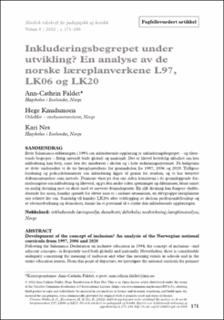| dc.contributor.author | Faldet, Ann-Cathrin | |
| dc.contributor.author | Knudsmoen, Hege | |
| dc.contributor.author | Nes, Kari | |
| dc.date.accessioned | 2022-09-07T09:28:50Z | |
| dc.date.available | 2022-09-07T09:28:50Z | |
| dc.date.created | 2022-08-29T11:36:15Z | |
| dc.date.issued | 2022 | |
| dc.identifier.citation | Nordisk tidsskrift for pedagogikk og kritikk. 2022, 8, 171-188. | en_US |
| dc.identifier.issn | 2387-5739 | |
| dc.identifier.uri | https://hdl.handle.net/11250/3016235 | |
| dc.description | © 2022 Ann-Cathrin Faldet, Hege Knudsmoen & Kari Nes. This is an Open Access article distributed under the terms of the Creative Commons Attribution 4.0 International License (https://creativecommons.org/licenses/BY/4.0/), allowing third parties to copy and redistribute the material in any medium or format and to remix, transform, and build upon the material for any purpose, even commercially, provided the original work is properly cited and states its license. | en_US |
| dc.description.abstract | Etter Salamanca-erklæringen i 1994 om inkluderende opplæring er inkluderingsbegrepet – og tilstøtende begreper – flittig anvendt både globalt og nasjonalt. Det er likevel betydelig uklarhet om hva inkludering kan bety, samt hva det innebærer i skolen og i hele utdanningssystemet. På bakgrunn av dette undersøker vi de tre læreplanverkene for grunnskolen fra 1997, 2006 og 2020. Tidligere forskning og policydokumenter om inkludering ligger til grunn for studien, og vi har benyttet dokumentanalyse som metode. Funnene viser på den ene siden konsistens i de grunnleggende formuleringene om inkludering og likeverd, og på den andre siden spenninger og dilemmaer, blant annet en mulig dreining mot en skole med et snevrere kunnskapssyn. En slik dreining kan fungere ekskluderende for noen, kanskje spesielt for elever som er i sårbare situasjoner, en elevgruppe læreplanene sier relativt lite om. Samtidig vil kanskje LK20s økte vektlegging av skolens profesjonsfellesskap og av elevmedvirkning og demokrati, kunne ha et potensial til å styrke den inkluderende opplæringen | en_US |
| dc.description.abstract | Abstract: Following the Salamanca Declaration on inclusive education in 1994, the concept of inclusion—and adjacent concepts—is frequently used both globally and nationally. Nevertheless, there is considerable ambiguity concerning the meaning of inclusion and what this meaning entails in schools and in the entire education system. From this point of departure, we investigate the national curricula for primary and lower secondary schools from 1997, 2006 and 2020. Based on research literature and policy documents on inclusion, we have studied the curricula by using document analysis as a method. The findings show, on the one hand, consistency in the basic formulations on inclusion and equity, and, on the other hand, potential tensions and dilemmas, including a possible shift towards schooling with a narrower view of knowledge. This development may have exclusionary effects for some, such as students with disabilities or others who are in vulnerable situations; students who are rarely mentioned in the curricula. At the same time, the increased emphasis in LK20 on professional communities in schools and on student participation and democracy, could have the potential to strengthen inclusive education. | en_US |
| dc.language.iso | nob | en_US |
| dc.rights | Navngivelse 4.0 Internasjonal | * |
| dc.rights.uri | http://creativecommons.org/licenses/by/4.0/deed.no | * |
| dc.subject | inkluderende læringsmiljø | en_US |
| dc.subject | demokrati | en_US |
| dc.subject | deltakelse | en_US |
| dc.subject | medvirkning | en_US |
| dc.subject | læreplananalyse | en_US |
| dc.subject | Norge | en_US |
| dc.subject | inclusive learning environment | en_US |
| dc.subject | democracy | en_US |
| dc.subject | participation | en_US |
| dc.subject | analysis of national curriculum | en_US |
| dc.subject | Norway | en_US |
| dc.title | Inkluderingsbegrepet under utvikling? En analyse av de norske læreplanverkene L97, LK06 og LK20 | en_US |
| dc.title.alternative | Development of the concept of inclusion? An analysis of the Norwegian national curricula from 1997, 2006 and 2020 | en_US |
| dc.type | Peer reviewed | en_US |
| dc.type | Journal article | en_US |
| dc.description.version | publishedVersion | en_US |
| dc.subject.nsi | VDP::Samfunnsvitenskap: 200::Pedagogiske fag: 280 | en_US |
| dc.source.pagenumber | 171-188 | en_US |
| dc.source.volume | 8 | en_US |
| dc.source.journal | Nordisk tidsskrift for pedagogikk og kritikk | en_US |
| dc.identifier.doi | https://doi.org/10.23865/ntpk.v8.3434 | |
| dc.identifier.cristin | 2046650 | |
| cristin.ispublished | true | |
| cristin.fulltext | original | |
| cristin.qualitycode | 1 | |

